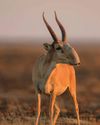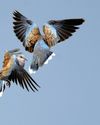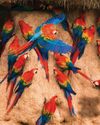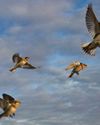
In the UK, you’re most likely to see the common glow-worm, found across Europe and Asia. In the northern hemisphere, ‘glow-worms’ are not worms at all, but beetles from the family Lampyridae. The females don’t have wings and look similar to the larvae. During the day, the female hides underground. At night, she crawls up a plant stem and turns on the light in her abdomen in the hope of attracting a passing mate.
In Australasia, the term ‘glow-worm’ refers to the larvae of little flies that feed on fungi. Some of these fungus gnats are carnivorous, luring prey with a blue-green glow emitted from a light organ at the end of their body. The bioluminescent spectacle of the lethal Arachnocampa luminosa larvae draws tourists from around the world to sites such as Waitomo Cave in New Zealand.
Esta historia es de la edición March 2021 de BBC Wildlife.
Comience su prueba gratuita de Magzter GOLD de 7 días para acceder a miles de historias premium seleccionadas y a más de 9,000 revistas y periódicos.
Ya eres suscriptor ? Conectar
Esta historia es de la edición March 2021 de BBC Wildlife.
Comience su prueba gratuita de Magzter GOLD de 7 días para acceder a miles de historias premium seleccionadas y a más de 9,000 revistas y periódicos.
Ya eres suscriptor? Conectar

SNAP-CHAT
Justin Gilligan on giant spider crabs and holding hands with an octopus

STEPPE CHANGE
Herds of saiga have returned to Kazakhstan, but there's a fine balance to tread

TREES FOR LIFE
Community is at the heart of conservation in the tropical forests of southern Belize

WHEN DOVES CRY
Turtle doves are now the UK's fastest declining bird species, but the RSPB is on a mission to save them

SURVIVAL OF THE CUTEST
We can't help being drawn to cute creatures, but our aesthetic preferences both help and hinder conservation

LIGHT ON THE NORTH
Spectacular images of Arctic foxes, reindeer and musk oxen reveal the wild beauty and diversity of Scandinavia

ROLLING IN THE DEEP
The super-sized crustacean that lives in the deepest, darkest ocean

LET'S GET TOGETHER
Clay licks deep in the Amazon explode in a riot of colour, with macaws the stars of the show

FEMALE OF THE SPECIES
To sponge or not to sponge? That is the question for the bottlenose dolphins (Tursiops aduncus) living in Shark Bay, Western Australia.

7 nature encounters for the month ahead
WITH NATURALIST AND AUTHOR BEN HOARE